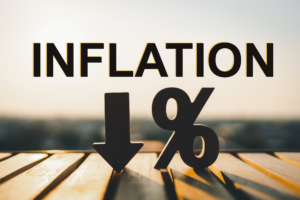Happy Summer! We hope this commentary finds you and your loved ones well as we enter the second half of 2023. We recently marked the end of an eventful first half of the year, with the Nasdaq Composite leading the way with a surge of 31.7%. This impressive performance makes it the Nasdaq’s best first half since 1983. This is truly a remarkable rally after a 33.1% decline last year. The S&P 500 and Dow Jones Industrial Average also performed well in the first half of the year. The S&P recorded a 15.9% increase, marking its best first half since 2019, while the Dow climbed 3.8%.
In addition to concerns over inflation earlier in the year, interest rates climbed to their highest level in 16 years within just 10 months. These elevated rates caused three regional banks to buckle in March and one in May. However, technology stocks, typically sensitive to borrowing costs, have remained resilient. Notably, Apple’s market capitalization surpassed $3 trillion, making it the first publicly traded company to achieve this milestone. The continued strength of stocks in the face of rising interest rates is certainly cause for celebration.
 The positive news doesn’t end there. The annual inflation rate in the United States has declined from its peak of 9.1% in June of the previous year to a more manageable 3%, just slightly above the Federal Reserve’s target of 2%. Core inflation, which excludes volatile food and energy prices, still remains higher at 4.8%, indicating persistent inflationary trends. This could lead the Federal Reserve to continue raising interest rates throughout the remainder of the year.
The positive news doesn’t end there. The annual inflation rate in the United States has declined from its peak of 9.1% in June of the previous year to a more manageable 3%, just slightly above the Federal Reserve’s target of 2%. Core inflation, which excludes volatile food and energy prices, still remains higher at 4.8%, indicating persistent inflationary trends. This could lead the Federal Reserve to continue raising interest rates throughout the remainder of the year.
Most economists anticipate a downward trend in inflation, suggesting that the Federal Reserve is close to accomplishing its mission. It is now apparent to many that the inflation shock is over, confirming that the inflation spike experienced in the United States was, for the most part, transitory. It is evident that disruptions in supply chains, and changes in spending patterns due to the COVID-19 pandemic played a substantial role in rising costs. Furthermore, a global economic recovery and Russia’s invasion of Ukraine heightened energy prices, adding to the existing fear premium.
Many of these contributing factors are now diminishing, which explains the decrease in inflation. The spike in spending on goods during the pandemic, as people were confined to their homes, drove goods inflation to as high as 14% in March 2022. Since then, as spending shifted back to services like travel and dining out, goods inflation has been steadily declining, with prices even turning negative, falling by nearly 1% year over year.
Currently, the increase in the cost of services accounts for almost all inflation, with services experiencing a 6.2% rise over the past 12 months. However, this is a decline from the peak of 7.3% seen in February.
While inflation remains uneven across various sectors, consumers will still notice elevated prices in areas such as rent, groceries, and restaurant meals, even as overall inflation eases. New car prices, which spiked during the pandemic, have seen the annual rate of inflation drop to around 4%.
The majority of our expectations for the first half of the year were met. Inflation showed signs of easing, US economic growth experienced a slowdown, the Federal Reserve’s rate-hike cycle neared its potential conclusion, and the US government successfully resolved the debt ceiling standoff, averting a possible default.
We were somewhat taken by surprise, however, at the strength displayed by the broader stock market. Initially, we anticipated a challenging first half, followed by a more positive second half. The unexpected robust performance was primarily driven by a few mega-cap stocks.
Higher interest rates would generally be expected to negatively impact tech companies. However, a select few tech shares have defied expectations and accounted for the majority of this year’s market gains, even in the face of higher rates.
Remarkably, the seven largest tech companies in the S&P 500 have witnessed an average increase of 86% year to date. In stark contrast, the remaining 493 companies in the index have experienced minimal movement. Solid and reliable blue-chip stocks outside the tech sector have largely remained stagnant. This raises the question of why these fundamentally sound companies are being overlooked, while tech stocks continue to surge. The availability of alternative investment options cannot be blamed, as there are 5% Treasury bills and enticing money market yields.
witnessed an average increase of 86% year to date. In stark contrast, the remaining 493 companies in the index have experienced minimal movement. Solid and reliable blue-chip stocks outside the tech sector have largely remained stagnant. This raises the question of why these fundamentally sound companies are being overlooked, while tech stocks continue to surge. The availability of alternative investment options cannot be blamed, as there are 5% Treasury bills and enticing money market yields.
In the fixed income market, returns remained positive across various asset classes until early June. This positive trend was observed in short-term Treasuries as well as high-yield corporate bonds. Moving forward into the second half, we generally anticipate similar favorable results. We continue to find international stocks attractive, supported by more favorable valuations and faster earnings growth.
Despite these positive developments, we must acknowledge that challenges still lie ahead. The US stock market remains susceptible to bouts of volatility or weakness, which can be attributed to ongoing uncertainty surrounding Federal Reserve policies, weaker corporate earnings, potentially overheated investor sentiment, and the looming risk of the “rolling” recession transitioning into a full-fledged economic downturn.
However, there is reason to be optimistic about the prospects of the second half of the year. There is no inherent obstacle preventing the US economy and the US stock market from flourishing during rate-hike cycles. The behavior of the market is primarily influenced by the magnitude and pace of rate hikes.
In the previous year, both of these driving forces worked against us. The Federal Reserve was urgently attempting to catch up with inflation, resulting in an unprecedented rate-hike pace from March to December. Consequently, markets were in a constant state of readjustment and repricing. In looking ahead to 2023, we observe a more thoughtful Federal Reserve that relies on data, leading to a significant reduction in the magnitude of rate hikes. Furthermore, the pace of rate hikes is expected to slow down considerably.
Since the end of May, the market recovery has been expanding, encompassing all segments of the US stock market. This phenomenon is not unusual. During the initial six to nine months of a cyclical bull recovery period, the performance of the market can appear distorted. However, for the recovery to sustain itself, it is crucial for it to broaden and involve more participants. Fortunately, this broadening is now becoming evident, paving the way for diligent stock-pickers to find opportunities.
In addition to this positive development, the resilience of the US economy, the passing of the trough quarter for corporate earnings, and the gradual moderation of inflation all indicate that the market can continue its forward momentum at a steady and consistent pace throughout the second half of the year.
Equities appear to be more influenced by long-term earnings projections rather than the current rate cycle. This raises the question of where earnings are headed. It is expected that earnings will reach their lowest point in the third quarter before experiencing a recovery in 2024. If this projection holds true, the valuation expansion observed since the market’s low in October, which saw the price-to-earnings ratio rise from 15.3x to 19.5x, is justified and can continue. In fact, it could lead to a meaningful multiple expansion based on next year’s earnings forecast, potentially driving the S&P 500 to new all-time highs.
 Of course, predictions in the near term are never a certainty. Therefore, an important part of the process is to ensure that your investment allocation currently meets your level of risk tolerance and your individual goals. This is a great time to review your financial plan and adjust expectations. We strongly encourage you to take advantage of all that our Firm’s resources can bring to bear for you, which should help you to face the uncertain future with confidence.
Of course, predictions in the near term are never a certainty. Therefore, an important part of the process is to ensure that your investment allocation currently meets your level of risk tolerance and your individual goals. This is a great time to review your financial plan and adjust expectations. We strongly encourage you to take advantage of all that our Firm’s resources can bring to bear for you, which should help you to face the uncertain future with confidence.
As always, please feel free to reach out to our team so that we can review your specific personal situation, and ensure that your portfolio is constructed appropriately. We appreciate the opportunity to serve you and your financial needs, and appreciate the continued trust and confidence that you have placed in us as your financial partners.

Scott A. Goginsky, CFA®
Partner, Research Analyst, Portfolio Manager
Sources: Index returns, Interest rates – CNBC; Inflation data – Yahoo Finance; Market outlook – Charles Schwab; P/E Ratio – Fidelity Investments
The information set forth regarding investments was obtained from sources that we believe reliable but we do not guarantee its accuracy or completeness. Neither the information nor opinion expressed constitutes a solicitation by us of the purchase or sale of any securities. Past performance does not guarantee future results.



Second Quarter 2023 Market Commentary
Scott A. Goginsky, CFA®
Happy Summer! We hope this commentary finds you and your loved ones well as we enter the second half of 2023. We recently marked the end of an eventful first half of the year, with the Nasdaq Composite leading the way with a surge of 31.7%. This impressive performance makes it the Nasdaq’s best first half since 1983. This is truly a remarkable rally after a 33.1% decline last year. The S&P 500 and Dow Jones Industrial Average also performed well in the first half of the year. The S&P recorded a 15.9% increase, marking its best first half since 2019, while the Dow climbed 3.8%.
In addition to concerns over inflation earlier in the year, interest rates climbed to their highest level in 16 years within just 10 months. These elevated rates caused three regional banks to buckle in March and one in May. However, technology stocks, typically sensitive to borrowing costs, have remained resilient. Notably, Apple’s market capitalization surpassed $3 trillion, making it the first publicly traded company to achieve this milestone. The continued strength of stocks in the face of rising interest rates is certainly cause for celebration.
Most economists anticipate a downward trend in inflation, suggesting that the Federal Reserve is close to accomplishing its mission. It is now apparent to many that the inflation shock is over, confirming that the inflation spike experienced in the United States was, for the most part, transitory. It is evident that disruptions in supply chains, and changes in spending patterns due to the COVID-19 pandemic played a substantial role in rising costs. Furthermore, a global economic recovery and Russia’s invasion of Ukraine heightened energy prices, adding to the existing fear premium.
Many of these contributing factors are now diminishing, which explains the decrease in inflation. The spike in spending on goods during the pandemic, as people were confined to their homes, drove goods inflation to as high as 14% in March 2022. Since then, as spending shifted back to services like travel and dining out, goods inflation has been steadily declining, with prices even turning negative, falling by nearly 1% year over year.
Currently, the increase in the cost of services accounts for almost all inflation, with services experiencing a 6.2% rise over the past 12 months. However, this is a decline from the peak of 7.3% seen in February.
While inflation remains uneven across various sectors, consumers will still notice elevated prices in areas such as rent, groceries, and restaurant meals, even as overall inflation eases. New car prices, which spiked during the pandemic, have seen the annual rate of inflation drop to around 4%.
The majority of our expectations for the first half of the year were met. Inflation showed signs of easing, US economic growth experienced a slowdown, the Federal Reserve’s rate-hike cycle neared its potential conclusion, and the US government successfully resolved the debt ceiling standoff, averting a possible default.
We were somewhat taken by surprise, however, at the strength displayed by the broader stock market. Initially, we anticipated a challenging first half, followed by a more positive second half. The unexpected robust performance was primarily driven by a few mega-cap stocks.
Higher interest rates would generally be expected to negatively impact tech companies. However, a select few tech shares have defied expectations and accounted for the majority of this year’s market gains, even in the face of higher rates.
Remarkably, the seven largest tech companies in the S&P 500 have witnessed an average increase of 86% year to date. In stark contrast, the remaining 493 companies in the index have experienced minimal movement. Solid and reliable blue-chip stocks outside the tech sector have largely remained stagnant. This raises the question of why these fundamentally sound companies are being overlooked, while tech stocks continue to surge. The availability of alternative investment options cannot be blamed, as there are 5% Treasury bills and enticing money market yields.
witnessed an average increase of 86% year to date. In stark contrast, the remaining 493 companies in the index have experienced minimal movement. Solid and reliable blue-chip stocks outside the tech sector have largely remained stagnant. This raises the question of why these fundamentally sound companies are being overlooked, while tech stocks continue to surge. The availability of alternative investment options cannot be blamed, as there are 5% Treasury bills and enticing money market yields.
In the fixed income market, returns remained positive across various asset classes until early June. This positive trend was observed in short-term Treasuries as well as high-yield corporate bonds. Moving forward into the second half, we generally anticipate similar favorable results. We continue to find international stocks attractive, supported by more favorable valuations and faster earnings growth.
Despite these positive developments, we must acknowledge that challenges still lie ahead. The US stock market remains susceptible to bouts of volatility or weakness, which can be attributed to ongoing uncertainty surrounding Federal Reserve policies, weaker corporate earnings, potentially overheated investor sentiment, and the looming risk of the “rolling” recession transitioning into a full-fledged economic downturn.
However, there is reason to be optimistic about the prospects of the second half of the year. There is no inherent obstacle preventing the US economy and the US stock market from flourishing during rate-hike cycles. The behavior of the market is primarily influenced by the magnitude and pace of rate hikes.
In the previous year, both of these driving forces worked against us. The Federal Reserve was urgently attempting to catch up with inflation, resulting in an unprecedented rate-hike pace from March to December. Consequently, markets were in a constant state of readjustment and repricing. In looking ahead to 2023, we observe a more thoughtful Federal Reserve that relies on data, leading to a significant reduction in the magnitude of rate hikes. Furthermore, the pace of rate hikes is expected to slow down considerably.
Since the end of May, the market recovery has been expanding, encompassing all segments of the US stock market. This phenomenon is not unusual. During the initial six to nine months of a cyclical bull recovery period, the performance of the market can appear distorted. However, for the recovery to sustain itself, it is crucial for it to broaden and involve more participants. Fortunately, this broadening is now becoming evident, paving the way for diligent stock-pickers to find opportunities.
In addition to this positive development, the resilience of the US economy, the passing of the trough quarter for corporate earnings, and the gradual moderation of inflation all indicate that the market can continue its forward momentum at a steady and consistent pace throughout the second half of the year.
Equities appear to be more influenced by long-term earnings projections rather than the current rate cycle. This raises the question of where earnings are headed. It is expected that earnings will reach their lowest point in the third quarter before experiencing a recovery in 2024. If this projection holds true, the valuation expansion observed since the market’s low in October, which saw the price-to-earnings ratio rise from 15.3x to 19.5x, is justified and can continue. In fact, it could lead to a meaningful multiple expansion based on next year’s earnings forecast, potentially driving the S&P 500 to new all-time highs.
As always, please feel free to reach out to our team so that we can review your specific personal situation, and ensure that your portfolio is constructed appropriately. We appreciate the opportunity to serve you and your financial needs, and appreciate the continued trust and confidence that you have placed in us as your financial partners.
Scott A. Goginsky, CFA®
Partner, Research Analyst, Portfolio Manager
Sources: Index returns, Interest rates – CNBC; Inflation data – Yahoo Finance; Market outlook – Charles Schwab; P/E Ratio – Fidelity Investments
The information set forth regarding investments was obtained from sources that we believe reliable but we do not guarantee its accuracy or completeness. Neither the information nor opinion expressed constitutes a solicitation by us of the purchase or sale of any securities. Past performance does not guarantee future results.